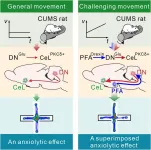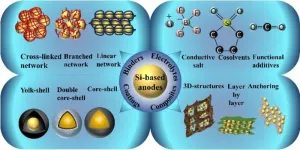(Press-News.org) Harmful emissions from the industrial sector could be reduced by up to 85% across the world, according to new research.
The sector, which includes iron and steel, chemicals, cement, and food and drink, emits around a quarter of global greenhouse gas (GHG) emissions - planet-warming gases that result in climate change and extreme weather.
This new study, led by the University of Leeds as part of its contribution to the UK Energy Research Centre (UKERC), found that decarbonising the sector is technically possible with a mix of “high and low-maturity” technologies - those that are tried and tested, along with upcoming tech that is not yet ready to be used in industry.
Lead author of the study, Ahmed Gailani, Research Fellow in Industrial Decarbonisation in Leeds’ School of Chemical and Process Engineering, said: “Decarbonisation is a global priority for governments, companies, and society at large, because it plays such a vital role in limiting global warming.
“Our findings represent a major step forward in helping to design industrial decarbonisation strategies and that is a really encouraging prospect when it comes to the future health of the planet.”
Net zero target
The UK has pledged to reduce its GHG emissions to net zero by 2050, meaning it will take as much of the damaging gases out of the atmosphere as it puts in.
This new research, published today in the journal Joule, looked at ways this could be achieved for industry. It found that established “medium to high maturity” technologies that involve carbon capture and storage, or fuel switching to hydrogen or biomass, can save on average nearly 85% of emissions in most industrial sectors.
It also suggests that low-maturity electric technologies, such as electric steam crackers - which are key equipment to produce petrochemical products - can theoretically decarbonise between 40% and 100% of the sector’s direct emissions. Other new electrification technologies can also help reduce emissions from energy-intensive processes such as steel, cement, and ceramics, which in some cases hadn’t previously been thought possible.
Some of the results from the study have already been included in a consultation on enabling industrial electrification by the UK’s Department of Energy Security and Net Zero.
Industrial products such as steel, chemicals and cement are widely used across the global economy. The demand for, and production of, these materials has increased significantly over recent decades, leading to high energy consumption and GHG emissions. However, global industrial emissions will need to be almost eliminated to meet the Paris Agreement targets on climate change.
Peter Taylor, a co-author of the study and Professor of Sustainable Energy Systems in the Schools of Earth and Environment and Chemical and Process Engineering at Leeds, said: “Industrial decarbonisation is challenging compared to other sectors but can be achieved if evidence-based strategies are designed to enable the development of new technologies, encourage investment in related infrastructure, and reduce other barriers that make it difficult for companies to take action.”
He added: “For the UK, if we don't decarbonise industry, we won't meet our climate change targets and ultimately industry will move elsewhere because, in the long term, people will be looking for products made in a clean, green way and if our industry can’t produce these then it will become the industry of the past, not the industry of the future.”
Additional barriers
Dr Gailani said the study describes the sector’s decarbonisation as “technically possible” because although the researchers had reviewed the technologies applicable, they hadn’t factored in other barriers, such as those related to social, economic or infrastructure issues.
He added: “We wanted to be explicit about the fact that our focus was the technical side of industrial decarbonisation. There are of course many other barriers to overcome. For example, if carbon capture and storage technologies are needed but the means to transport CO2 are not yet in place, this lack of infrastructure will delay the emissions reduction process. There is still a great amount of work to be done.”
The uptake of many industrial decarbonisation technologies is currently impacted by high capital and operational costs, even if their technical challenges can be resolved. Electrification technologies typically have 2-3 times higher operational costs compared to fossil fuel-based technologies due to the higher cost of electricity in many markets.
The study was carried out in collaboration with researchers from the University of Bath and Imperial College London, and assessed the technical potential for emission and energy savings from the most important emission-reducing technologies.
The team reviewed the published research and other sources of data to find the abatement options applicable across all sectors and their technology readiness level (TRL). They reached the figure of 85% by calculating the emission abatement potential for the most promising technologies in each sector and taking the average. The sectors analysed were iron and steel; chemicals; cement and lime; food and drink; pulp and paper; glass; aluminium, refining and ceramics.
UKERC Director, Professor Rob Gross, said: “Industrial decarbonisation is an important research priority for UKERC as finding the most appropriate solutions requires a whole systems approach. Many of the most promising industrial abatement options rely on having access to supporting infrastructure whether that is hydrogen and CO2 pipelines, or upgraded electricity connections.”
Further research
Dr Gailani said the research was an important first step to help policy makers understand the potential of different emission reducing technologies that could be used in each industrial sector and therefore help them to make informed decisions about the best way forward. However, the team also noted that further research was needed to understand the practical potential to implement these technologies in different countries and regions. This would require careful understanding of local conditions including the socio-economic context, policy, markets and regulation, business models, infrastructure, and resource availability.
ENDS
Further information
For media enquiries please contact Leeds press officer Deb Newman at d.newman@leeds.ac.uk
The research paper “Assessing the potential of decarbonisation options for industrial sectors” is being published in the journal Joule at 4pm GMT (11am ET) on Wednesday, January 31, 2024. When the embargo lifts, the paper will be available on the journal website. DOI: 10.1016/j.joule.2024.01.007
Funding: The research was undertaken as part of the work programme of the UK Energy Research Centre (UKERC), which is funded by UK Research and Innovation (UKRI).
In addition to his role at Leeds, Dr Gailani is on secondment to the Climate Change Committee - the independent expert advisory body to the UK Government. He is also a Research Fellow with the UK Energy Research Centre and with the Energy Demand Research Centre.
University of Leeds
The University of Leeds is one of the largest higher education institutions in the UK, with more than 39,000 students from about 170 different countries. We are renowned globally for the quality of our teaching and research.
We are a values-driven university, and we harness our expertise in research and education to help shape a better future for humanity, working through collaboration to tackle inequalities, achieve societal impact and drive change.
The University is a member of the Russell Group of research-intensive universities, and is a major partner in the Alan Turing, Rosalind Franklin and Royce Institutes www.leeds.ac.uk
Follow University of Leeds or tag us into coverage: Twitter | Facebook | LinkedIn | Instagram
UK Energy Research Centre
The UK Energy Research Centre (UKERC) carries out world-class, interdisciplinary research into sustainable future energy systems. It is a focal point of UK energy research and a gateway between the UK and the international energy research communities. Our whole systems research informs UK policy development and research strategy. UKERC is funded by the UK Research and Innovation, Energy Programme. For further information on the UKERC please visit: https://ukerc.ac.uk
University of Bath
The University of Bath is one of the UK's leading universities for high-impact research with a reputation for excellence in education, student experience and graduate prospects.
We are named ‘University of the Year’ in The Times and The Sunday Times Good University Guide 2023, and ranked among the world’s top 10% of universities, placing 148th in the QS World University Rankings 2024. We are ranked 5th in the UK in the Complete University Guide 2024, 6th in the Guardian University Guide 2024 and 8th in The Times and Sunday Times Good University Guide 2024.
Imperial College London
Imperial College London is a global top ten university with a world-class reputation. Imperial’s 22,000 students and 8,000 staff are working to solve the biggest challenges in science, medicine, engineering and business.
Imperial ranks sixth in the 2024 QS World University Rankings and eighth in the 2024 Times Higher Education World University Rankings. The 2021 Research Excellence Framework (REF) found that it has a greater proportion of world-leading research than any other UK university. It also received a Gold Award in the 2023 Teaching Excellence Framework (TEF). Imperial was named University of the Year in the Daily Mail University Guide 2024, University of the Year for Graduate Employment in The Times and Sunday Times Good University Guide 2024 and awarded a Queen’s Anniversary Prize for its COVID-19 response. https://www.imperial.ac.uk/
END
Decarbonizing the world’s industries
2024-01-31
ELSE PRESS RELEASES FROM THIS DATE:
Brain protein’s virus-like structure may help explain cancer-induced memory loss
2024-01-31
In a rare but serious complication of cancer, the body’s own immune system can start attacking the brain, causing rapid-onset memory loss and cognitive deficits. What triggers this sudden biological civil war was largely unknown.
Now, researchers at University of Utah Health have found that some tumors can release a protein that looks like a virus, kickstarting an out-of-control immune reaction that may damage brain cells.
Their findings published in Cell on Jan. 31, 2024.
A rapid immune attack
Jason Shepherd, Ph.D., associate ...
Study finds brain mechanism for physical exercise improving mood
2024-01-31
"Only exercise can remove all kinds of doubts," Goethe said. Physical exercise is the lubricant between the body and the mind. Alleviation of anxiety by motor activity forms an integral part of our daily life; whether going for a walk to refresh our mind or running excessively in the park to recuperate from a stressful event, we are all well aware of the beneficial impact. In fact, the plain view that exercise can prevent anxiety and depression has been supported by accumulating prospective cohort studies in recent years. Yet, apart from some general interactions between the periphery of our body and our ...
Symbiotic autonomous robot ecosystem enhances safety and efficiency on nuclear facilities decommissioning
2024-01-31
Nuclear facilities, particularly during decommissioning, face significant challenges due to hazardous materials and environments. Traditional methods often rely heavily on human intervention, posing risks and inefficiencies. A groundbreaking research introduces a symbiotic autonomous robot ecosystem, designed to transform nuclear facility decommissioning. This innovative approach leverages a Cyber-Physical System (CPS) coordinated through a digital twin interface, significantly enhancing safety, efficiency, and operational awareness ...
Alleviate the drought in the east Hungarian plains
2024-01-31
Intensive agricultural cultivation and the resulting changes in soil structure cause low humidity in the near-surface air during heat waves in really dry years. As a result, summer cold fronts roar across the Plain without the usual thunderstorms and precipitation, researchers at the Institute of Geography and Earth Sciences at Eötvös Loránd University explain in a review of articles on topics ranging from geodynamics to soil science to meteorology what made the summer of 2022 so severe in the eastern part of the country.
In 2022, the 7-week period starting in mid-June was disastrous for eastern Hungary. Almost no rain fell for weeks, and in the eastern part of the country, ...
Researchers overview recent progress and challenges in silicon-based anode materials for lithium-ion batteries
2024-01-31
Research in recent years displays that several chemical modifications (binders, composite materials, and electrolytes) provide superior stability and enhance electrochemical performance in Si-based anodes in lithium-ion batteries (LIBs). Thus far, several different chemical interactions on structural alterations to Si-based anode materials have been tried to enhance Li+ kinetics, structural stability, and volume development control throughout the delithiation/lithiation process.
Despite significant advancements, Si and Si-based electrodes are still in their infancy and are still far from finding widespread practical use. Si-based anodes face some difficulties, including substantial ...
News on drug-induced skin swelling
2024-01-31
Angiotensin-converting enzyme inhibitors - ACE inhibitors for short - are effective antihypertensive drugs. They block the formation of the hormone angiotensin II, which plays a central role in the development of high blood pressure. On the other hand, these drugs increase the concentration of the vasoactive signaling substance bradykinin. Among other things, this can lead to acute swelling of the skin or mucous membranes. In general, such swellings are not life-threatening. However, if they affect the tongue, throat or larynx, angioedema can be life-threatening for the patient due to the potential risk of suffocation. Research to date suggests that susceptibility to such drug-induced angioedema ...
Innovation on the design, construction, and experiments of OMEGA-based SSPS prototype: The Sun-Chasing Project
2024-01-31
Space solar power satellite (SSPS) is a tremendous energy system that collects and converts solar power to electric power in space, and then transmits the electric power to earth, spacecraft, or moving targets via microwave. It is regarded as one of the most potential ways to solve the problem of energy crisis.
In 2022, a team of researchers from Xidian University in China has completed a full-link and full-system ground demonstration and verification system for an SSPS, named the Sun-Chasing Project. Their study, recently published in Engineering, introduces the design concept of OMEGA 2.0 SSPS, the related key technologies, and the development of ground demonstration ...
SCAI publishes expert consensus statement on management of calcified coronary lesions requiring intervention
2024-01-31
WASHINGTON—Coronary artery calcification is increasing in prevalence, leading to greater risks both during procedures such as percutaneous coronary intervention (PCI) and adverse events in the short and long term. Along with these challenges, treatment options are expanding, increasingly including calcium modification prior to stent implantation. A newly published SCAI Expert Consensus Statement on the Management of Calcified Coronary Lesions outlines methods for interventional cardiologists to identify various types of calcified coronary lesions ...
Firing nerve fibers in the brain are supplied with energy on demand
2024-01-31
Brain function depends on the swift movement of electrical signals along axons, the long extensions of nerve cells that connect billions of brain cells. The nerve fibers are insulated by a fatty layer called myelin, which is produced by specialized cells called oligodendrocytes. These cells wrap around and insulate nerve fibers ensuring the rapid and efficient transmission of signals that is essential for brain function.
Oligodendrocytes sense and respond to the electrical signals
Now, a team of neuroscientists led by Aiman Saab at the Institute of Pharmacology and Toxicology at the University ...
Engineering viruses to kill deadly pathogens
2024-01-31
Northwestern University researchers have successfully coaxed a deadly pathogen to destroy itself from the inside out.
In the new study, researchers modified DNA from a bacteriophage or “phage,” a type of virus that infects and replicates inside of bacteria. Then, the research team put the DNA inside Pseudomonas aeruginosa (P. aeruginosa), a deadly bacterium that is also highly resistant to antibiotics. Once inside the bacterium, the DNA bypassed the pathogen’s defense mechanisms ...







